Israel 2000 "Dinosaur, Judean Hills"
| Issue Date | 05.12.2000 |
| ID | Michel: 1576-1578, Scott: 1421-1423, Stanley Gibbons: 1501-1503, Yvert et Tellier: 1507-1509, Category: pR |
| Design | Tuvia. Kurz |
| Stamps in set | 3 |
| Values | NIS 2.20 x 3 - Struthiomimus in motion |
| Emission/Type | commemorative |
| Issue places | Tel-Aviv |
| Size (width x height) | 30.8mm x 30.8mm |
| Layout | MS of 9 stamps and 3 tabs |
| Products | FDC x2, Booklet x1 |
| Paper | with phosphor strips |
| Perforation | 13 x 13 |
| Print Technique | Offset, multi-color |
| Printed by | Government Printers |
| Quantity | |
| Issuing Authority | Israel Post |
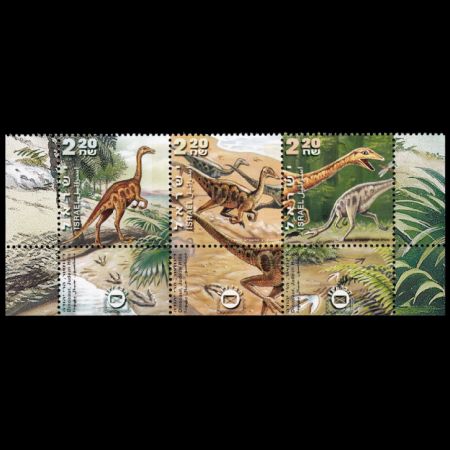
On December 5th, 2000, the Post Authority of Israel issued the set of three stamps "Dinosaur, Judean Hills". These stamps were printed a sheet of 9, with three rows of one strip of 3 stamps each and shows Struthiomimus (ostrich like dinosaurs) in motion and its footprints on the tabs on the bottom side of the sheet.
The following text was written by Prof. Eitan Tsrenov from the Hebrew University in Jerusalem for these stamps press release, in 2000.
 |
The dinosaurs appeared on earth during the Triassic Period, 235 million years ago and continued to exist to the end of the Mezosoic (end of the Cretaceous) Era, when all of them, 65 million years ago, became extinct together with many other groups of organisms. The common explanation of this mass extinction is probably due to a massive impact of an asteroid with the face of the earth, the consequence of which was a worldwide catastrophe to life.
During most of their existence on earth (around 170 million years) the dinosaurs dominated most of the continental habitats, were wide spread all over the continents and fed on a broad spectrum of diets (from feeding on leaves to engaging a ferocious predatory behaviour). Some of them became highly socialized, laid eggs in bird-like nests ad protected their youngsters. Some others achieved huge dimensions of body-size.
In the settlements of Beit Zait near Jerusalem, footprints of some dinosaurs were found, which belong to a group of agile animals, running on their hind limbs, which their forelimbs were relatively very small, never used for locomotion, but rather helped then to grasp food or prey.
The late Prof. M. Avnimelech from the Hebrew University of Jerusalem identified those footprints as belonging to the genus Struthiomimus (=ostrich-like). Indeed, the reconstruction of the animal (exhibited in the backyard of the department of Geology in the Hebrew University) shows a artificial similarity with ostriches and their capability for a high-speed locomotion. Yet, contrary with all other birds, its body was covered with horny scales, showed no teeth in its jaws, which was covered with a horny sharp sheath and fed on leaves. The Beit Zait dinosaur was relatively small (150 kg, 4 meters long).
Related species of the same age were described from North America and Mongolia. Until now, no dinosaur bones were found in Israel, but the footprints of Beit Zait show that a band of this species ran about the shoreline of the old Tethys Ocean which, at that time, covered the coasts of the Middle East.
Products
| FDC | First-Day-of-Issue Postmarks | |
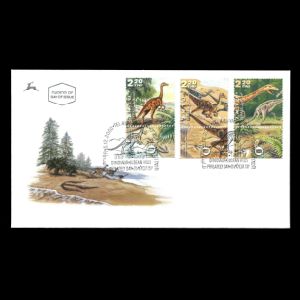 |
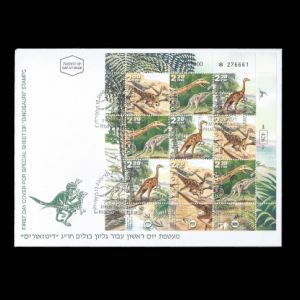 |
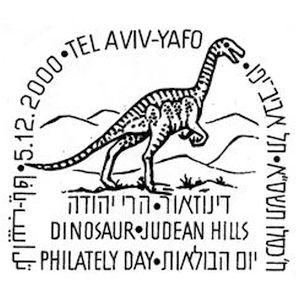 |
| Mini-Sheet | Booklet | |
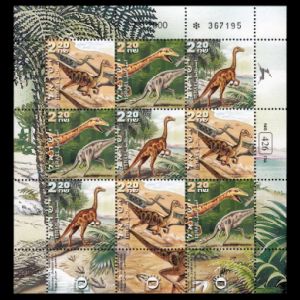 |
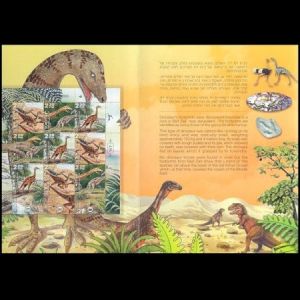 |
|
References

|
- Technical details and official press release:
official press release, Israel Philatelic Federation (the article does not exist anymore) colnect. -
Dinosaurs discovery in Israel:
MapLandia,
Acknowledgements
Many thanks to Dr. Peter Voice, PhD Department of Geological and Environmental Sciences, Western Michigan University, USA, for his help in finding information and for review of a draft of this article.| <prev | back to index | next> |